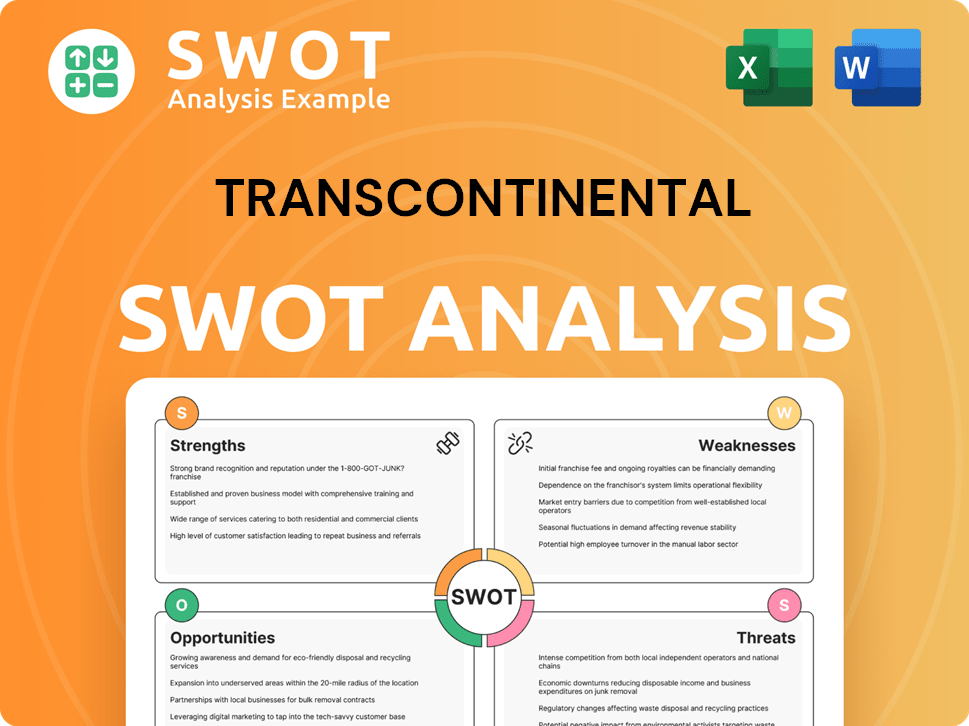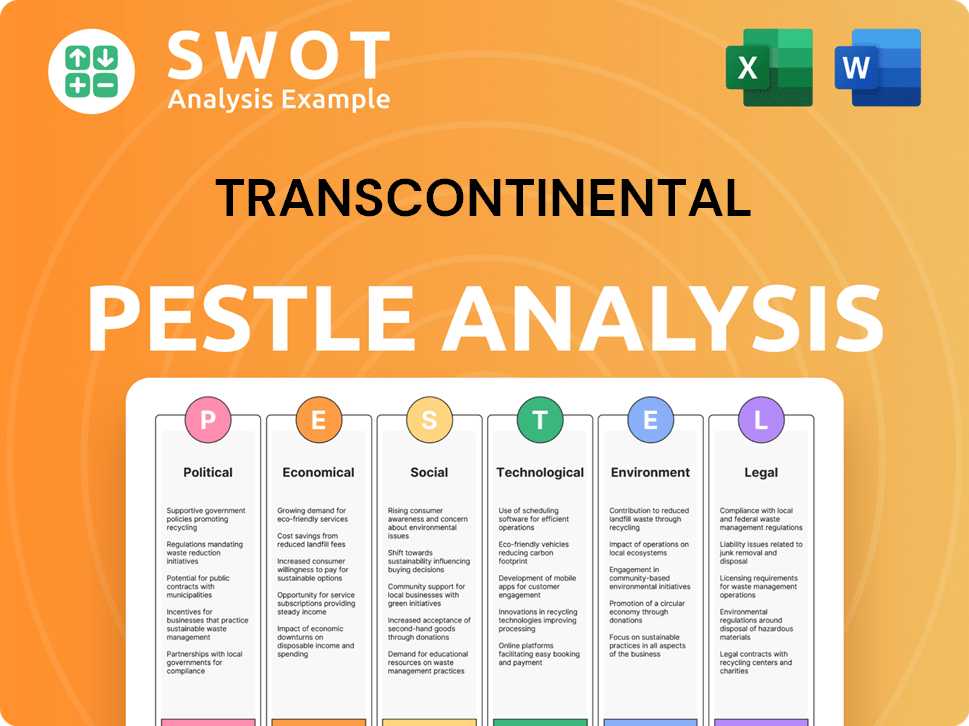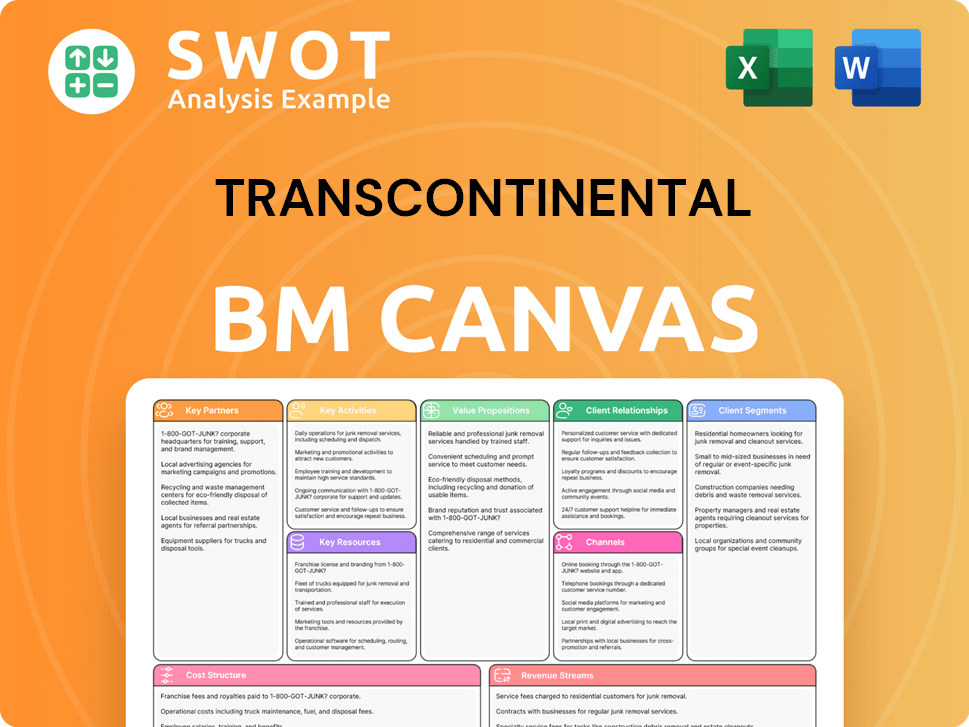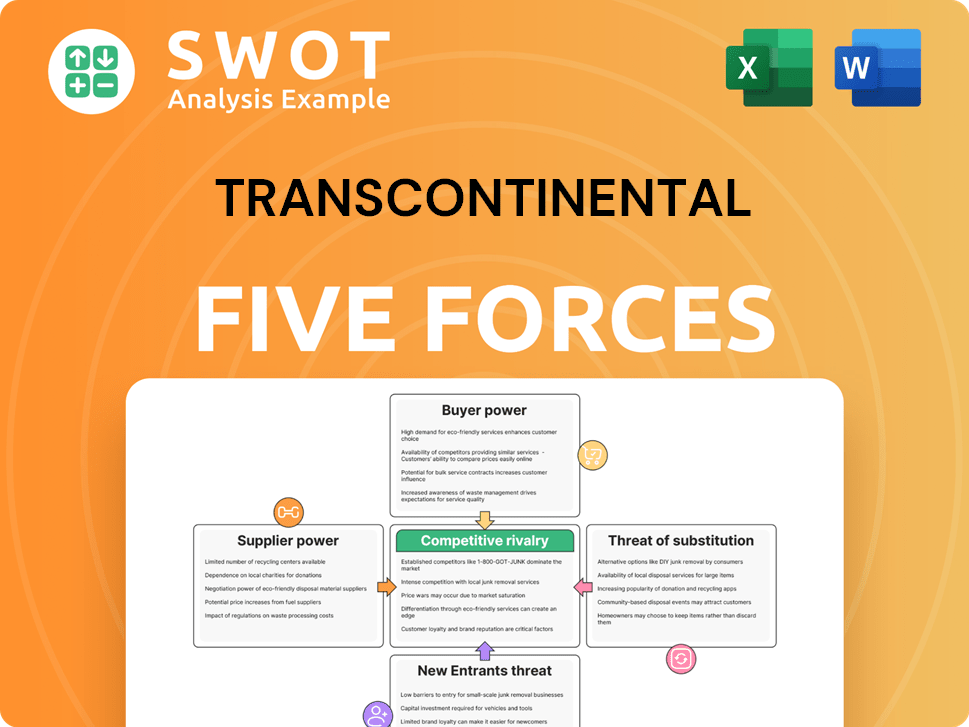Transcontinental Bundle
How Does Transcontinental Company Dominate Its Markets?
Transcontinental Inc. has dramatically transformed since its 1976 founding, evolving from a printing giant to a North American leader in flexible packaging. This strategic pivot, accounting for a significant portion of its multi-billion dollar revenue, showcases a dynamic Transcontinental SWOT Analysis. Discover how this Canadian company leverages its sales and marketing strategies to stay ahead in a competitive landscape.

This Company overview will explore the intricacies of Transcontinental Company's sales and marketing strategies, from its innovative sustainable packaging solutions to its targeted marketing campaigns. We'll analyze how Transcontinental Company positions itself in the market and the key elements of its business strategy that drive its consistent profitability improvements. Learn about the company's sales strategy for international markets and how it generates leads.
How Does Transcontinental Reach Its Customers?
The sales strategy of the company, a leader in flexible packaging, retail services, and media, involves a multi-channel approach to reach its diverse customer base. The company's sales and marketing efforts are tailored to the specific needs of each sector, leveraging direct sales, B2B relationships, and potentially e-commerce platforms. This approach is crucial for maintaining its market position and driving revenue growth across its business segments.
The company's marketing strategy focuses on providing tailored solutions to businesses, with a strong emphasis on direct engagement and consultative sales. This approach is evident in its Packaging, Retail Services, and Media sectors, where it aims to attract, reach, and retain customers through quality products and services. The company's commitment to innovation and customer-centric solutions supports its sales and marketing efforts.
Understanding the sales channels and marketing strategies of the company is crucial for assessing its overall business strategy and market performance. By analyzing its approach to sales and customer engagement, stakeholders can gain insights into how the company drives revenue and maintains its competitive edge in the market.
The Packaging sector, which accounted for 58% of the company's C$2.8 billion revenues in fiscal year 2024, relies heavily on direct sales teams. These teams engage with businesses requiring flexible plastic products. The company's North American network of 25 operating sites supports localized sales and distribution.
The Retail Services and Printing sector focuses on direct sales to retailers and businesses. This sector offers integrated solutions, including content production, marketing products, and in-store marketing. The evolution of services, such as the reinvented raddar™ flyer, indicates a shift toward digital integration.
The Media sector, primarily involving Canadian French-language educational publishing, likely uses traditional distribution channels. These include direct sales to educational institutions and partnerships with online and physical book retailers. The company's focus is on B2B sales across all segments.
The company's strategic acquisitions, such as Coveris Americas in 2018, have expanded its footprint in the flexible packaging market. The sale of its industrial packaging operations for US$95.0 million in October 2024 demonstrates portfolio optimization. These moves reflect the company's dynamic business strategy.
The company's sales strategy emphasizes direct engagement and tailored solutions, particularly in the Packaging and Retail Services sectors. Their marketing strategy is centered around providing value-added services and building strong B2B relationships. For a deeper dive into the company's overall approach, check out this article on the Growth Strategy of Transcontinental.
- Direct sales teams for Packaging and Retail Services.
- Focus on integrated solutions for retailers.
- Strategic acquisitions and divestitures to optimize the portfolio.
- Emphasis on B2B relationships and customer retention.
Transcontinental SWOT Analysis
- Complete SWOT Breakdown
- Fully Customizable
- Editable in Excel & Word
- Professional Formatting
- Investor-Ready Format

What Marketing Tactics Does Transcontinental Use?
The company's marketing tactics are designed to boost brand awareness, generate leads, and boost sales across its different business segments. Given its focus on business-to-business (B2B) operations, the company likely employs content marketing, direct engagement, and industry-specific outreach.
In the digital space, the company focuses on sustainable packaging solutions and the roll-out of its raddar™ flyer. This suggests content marketing efforts that highlight these innovations and their environmental benefits. The company's participation in the Science Based Targets initiative (SBTi) for greenhouse gas emission reduction further provides content for sustainability-focused marketing. The company's website acts as a central hub for investor information and news, indicating its role in digital communication and potentially lead generation through direct inquiries.
For its Retail Services and Printing Sector, which offers integrated solutions including in-store marketing, the company likely leverages its expertise in campaign management and analytics. This implies data-driven marketing approaches, customer segmentation, and personalization to deliver effective marketing products and services to retailers. The company's focus on 'marketing activation' suggests a strategic approach to bringing a brand message to life through integrated campaigns.
The company uses digital marketing to promote its flexible packaging capabilities and printing services. SEO and paid advertising are likely used to target business clients. The website serves as a central hub for digital communication and lead generation.
Content marketing emphasizes sustainable packaging solutions and the raddar™ flyer. This involves highlighting innovations and their environmental benefits. The company's participation in SBTi also provides content for sustainability-focused marketing.
The Retail Services and Printing Sector uses campaign management and analytics. This includes data-driven marketing, customer segmentation, and personalization. The focus is on delivering effective marketing products and services to retailers.
Traditional media includes print advertising, especially as Canada's largest printer. Targeted campaigns through industry publications are also utilized. Events and trade shows are probable avenues for lead generation and relationship building.
The company's commitment to corporate social responsibility, as outlined in its 2022-2025 Corporate Social Responsibility Plan, informs its marketing messaging. This emphasizes values like respect, teamwork, performance, and innovation. This aligns with a broader trend of socially conscious strategies in advertising.
The nature of their integrated solutions and data-driven approach implies significant use of technology platforms and analytics tools. These tools are used to optimize marketing efforts. This data-driven approach is crucial for the Growth Strategy of Transcontinental.
The company employs a mix of digital and traditional marketing strategies. This includes content marketing, SEO, and paid advertising. Data-driven approaches and customer segmentation are also key.
- Digital Marketing: SEO, paid advertising, and website management.
- Content Marketing: Focus on sustainable solutions and environmental benefits.
- Retail Services: Campaign management, analytics, and personalization.
- Traditional Media: Print advertising and industry publications.
- Corporate Social Responsibility: Emphasis on values like respect and teamwork.
- Data-Driven Approach: Use of technology platforms and analytics tools.
Transcontinental PESTLE Analysis
- Covers All 6 PESTLE Categories
- No Research Needed – Save Hours of Work
- Built by Experts, Trusted by Consultants
- Instant Download, Ready to Use
- 100% Editable, Fully Customizable

How Is Transcontinental Positioned in the Market?
The Transcontinental Company positions itself as a leader in its core markets, focusing on innovation, sustainability, and a comprehensive offering across flexible packaging, printing, and educational publishing. Their core message centers on delivering quality products and services to help businesses attract, reach, and retain customers. This is supported by strong corporate values, emphasizing respect, teamwork, performance, and innovation, which are key elements of their overall business strategy.
In the flexible packaging sector, the company highlights its position as a North American leader, with a strong emphasis on sustainable solutions. This involves significant investments in mono-material recyclable flexible packaging. In printing and retail services, the company differentiates itself through integrated solutions for retailers, including in-store marketing and content production, showcasing their ability to combine traditional print with new media.
The company’s brand consistently reflects its commitment to corporate social responsibility, including setting Science Based Targets initiative (SBTi) approved near-term greenhouse gas emission reduction targets. This focus on ESG (Environmental, Social, and Governance) targets and sustainable practices is a key aspect of their brand appeal. This approach has contributed to their strong financial performance, which in fiscal year 2024, included increased profitability and market value, reinforcing their brand as a high-performing organization. For more insights, check out Brief History of Transcontinental.
The company is positioned as a North American leader in flexible packaging. This is achieved through a focus on sustainable solutions. Their investment in mono-material recyclable flexible packaging is a key differentiator in the market.
They differentiate themselves through integrated solutions for retailers. This includes in-store marketing and content production. The reinvented raddar™ flyer, using less paper, showcases their eco-conscious approach.
Positioned as the leading Canadian French-language provider. They cater to a specific market need within the education sector. This strategic focus allows them to capture a niche market.
Maintains brand consistency through a unified corporate identity and shared values. Their commitment to corporate social responsibility strengthens their brand perception. This is crucial for their overall marketing strategy.
Transcontinental Business Model Canvas
- Complete 9-Block Business Model Canvas
- Effortlessly Communicate Your Business Strategy
- Investor-Ready BMC Format
- 100% Editable and Customizable
- Clear and Structured Layout

What Are Transcontinental’s Most Notable Campaigns?
The 'campaigns' of focus on strategic initiatives and product launches tailored to specific industry needs, primarily in business-to-business (B2B) sectors. These initiatives are designed to drive growth and strengthen the company's market position. A key aspect of their sales and marketing strategy involves adapting to evolving customer demands and market trends, especially in sustainable solutions.
One of the most significant recent 'campaigns' involves a strong emphasis on sustainable packaging solutions. This strategic direction is supported by substantial investments in new equipment and processes. These efforts are geared towards meeting the increasing demand for environmentally friendly products and services, which is a core component of their business strategy.
Another important 'campaign' is the successful implementation of the reinvented raddar™ flyer. This initiative highlights the company's commitment to offering more sustainable alternatives and maintaining its leadership in retail services. The success of this and other initiatives demonstrates the company's ability to adapt and innovate within its core markets.
The investment of $80 million in new equipment in Spartanburg, South Carolina, to produce mono-material recyclable flexible packaging is a key initiative. This supports customers' sustainability goals and expands market share in the sustainable packaging segment. This investment is a direct response to growing demand for environmentally friendly printing solutions and packaging.
The relaunch of the raddar™ flyer in Québec and British Columbia offered a more sustainable alternative to traditional flyers. This initiative reduced paper usage by 60% and eliminated plastic bag requirements. Launched in May 2023, it aligns with consumer preferences for eco-friendly solutions, reinforcing leadership in retail services.
A program to improve profitability and financial position, initiated in December 2023, involved cost reduction and strategic portfolio optimization. The sale of industrial packaging operations to Hood Packaging Corporation for US$95.0 million in October 2024 was part of this effort. This demonstrates a strategic 'campaign' focused on internal efficiency and financial health, directly impacting the company's ability to invest in future growth.
The program led to a 5.1% increase in adjusted operating earnings before depreciation and amortization in fiscal year 2024. These results highlight the effectiveness of the company's strategic initiatives in enhancing financial performance and market competitiveness. These improvements are critical for supporting future growth and innovation.
Transcontinental Porter's Five Forces Analysis
- Covers All 5 Competitive Forces in Detail
- Structured for Consultants, Students, and Founders
- 100% Editable in Microsoft Word & Excel
- Instant Digital Download – Use Immediately
- Compatible with Mac & PC – Fully Unlocked

Related Blogs
- What are Mission Vision & Core Values of Transcontinental Company?
- What is Competitive Landscape of Transcontinental Company?
- What is Growth Strategy and Future Prospects of Transcontinental Company?
- How Does Transcontinental Company Work?
- What is Brief History of Transcontinental Company?
- Who Owns Transcontinental Company?
- What is Customer Demographics and Target Market of Transcontinental Company?
Disclaimer
All information, articles, and product details provided on this website are for general informational and educational purposes only. We do not claim any ownership over, nor do we intend to infringe upon, any trademarks, copyrights, logos, brand names, or other intellectual property mentioned or depicted on this site. Such intellectual property remains the property of its respective owners, and any references here are made solely for identification or informational purposes, without implying any affiliation, endorsement, or partnership.
We make no representations or warranties, express or implied, regarding the accuracy, completeness, or suitability of any content or products presented. Nothing on this website should be construed as legal, tax, investment, financial, medical, or other professional advice. In addition, no part of this site—including articles or product references—constitutes a solicitation, recommendation, endorsement, advertisement, or offer to buy or sell any securities, franchises, or other financial instruments, particularly in jurisdictions where such activity would be unlawful.
All content is of a general nature and may not address the specific circumstances of any individual or entity. It is not a substitute for professional advice or services. Any actions you take based on the information provided here are strictly at your own risk. You accept full responsibility for any decisions or outcomes arising from your use of this website and agree to release us from any liability in connection with your use of, or reliance upon, the content or products found herein.